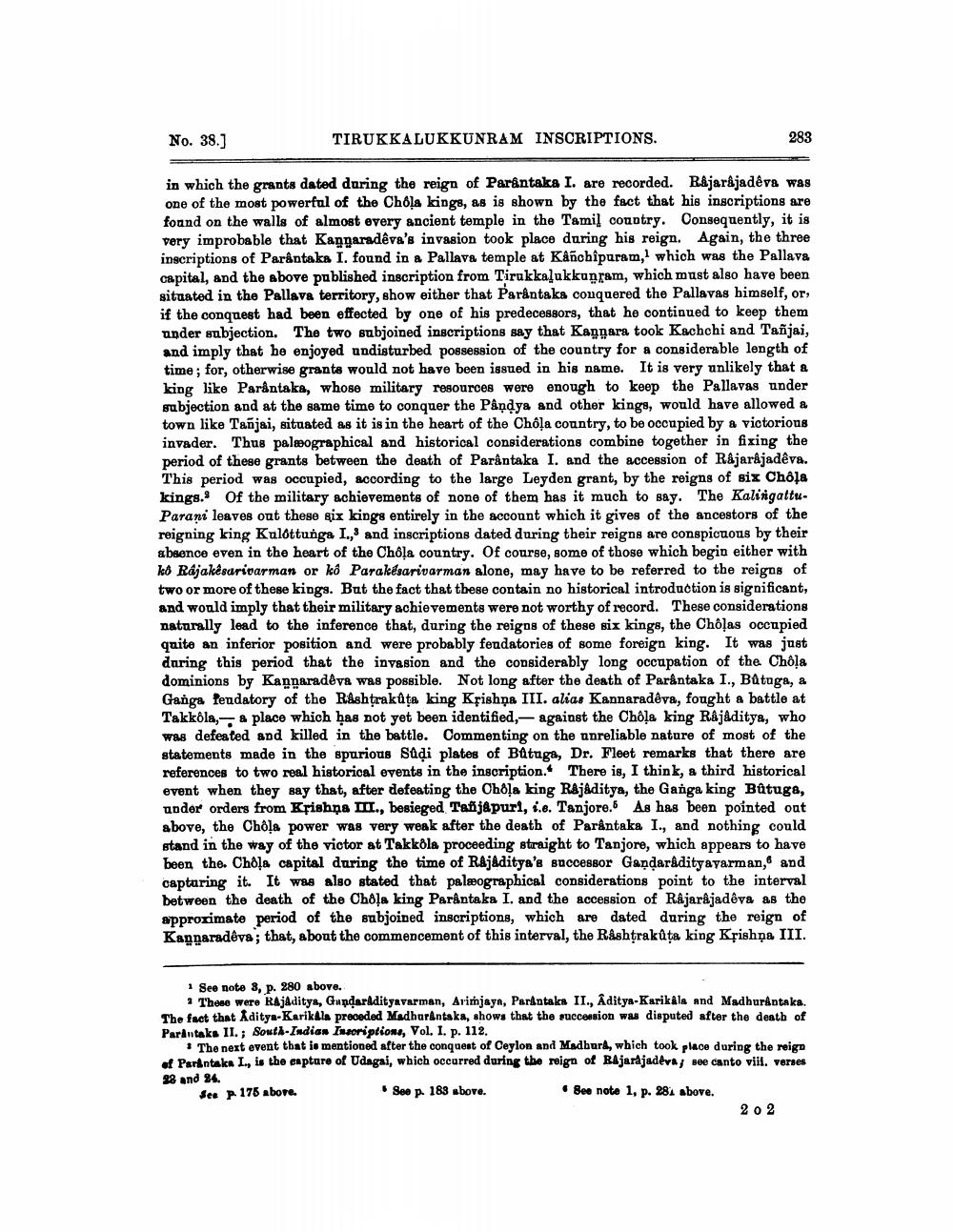________________
No. 38.]
TIRUKKALUKKUNRAM INSCRIPTIONS.
283
in which the grants dated during the reign of Parantaka I. are recorded. Rajarajadêya was one of the most powerful of the Chola kings, as is shown by the fact that his inscriptions are found on the walls of almost every ancient temple in the Tamil country. Consequently, it is very improbable that Kannaradeva's invasion took place during his reign. Again, the three inscriptions of Parântaka I. found in a Pallava temple at Kanchîpuram, which was the Pallava capital, and the above published inscription from Tirukkalukkugram, which must also have been situated in the Pallava territory, show either that Parantaka conquered the Pallavas himself, or, if the conquest had been effected by one of his predecessors, that he continued to keep them under subjection. The two subjoined inscriptions say that Kappara took Kachchi and Tañjai, and imply that he enjoyed undisturbed possession of the country for a considerable length of time; for, otherwise grants would not have been issued in his name. It is very unlikely that a king like Parantaka, whose military resources were enough to keep the Pallavas under subjection and at the same time to conquer the Pandya and other kings, would have allowed a town like Tañjai, situated as it is in the heart of the Chôļa country, to be occupied by a victorious invader. Thus palmographical and historical considerations combine together in fixing the period of these grants between the death of Parantaka I. and the accession of Rajarajadêva. This period was occupied, according to the large Leyden grant, by the reigns of six Chola kings. Of the military achievements of none of them has it much to say. The KalingattuParani leaves out these gix kings entirely in the account which it gives of the ancestors of the reigning king Kulóttunga I.,) and inscriptions dated during their reigns are conspicuous by their absence even in the heart of the Chôļa country. Of course, some of those which begin either with ko Rajakesarivarman or kô Parakésarivarman alone, may have to be referred to the reigns of two or more of these kings. But the fact that these contain no historical introduction is significant, and would imply that their military achievements were not worthy of record. These considerations naturally lead to the inference that, during the reigos of these six kings, the Cholas occupied quite an inferior position and were probably fendatories of some foreign king. It was just during this period that the invasion and the considerably long occupation of the Chola dominions by Kapnaradêya was possible. Not long after the death of Parantaka I., Batuga, a Ganga feudatory of the Rashtrakůta king Kfishna III. alias Kannarad@ya, fought a battle at Takkôla, & place which has not yet been identified, - against the Chola king Râjaditya, who was defeated and killed in the battle. Commenting on the unreliable nature of most of the statements made in the spurious Sadi plates of Butuga, Dr. Fleet remarks that there are references to two real historical events in the inscription. There is, I think, a third historical event when they say that, after defeating the Ohôļa king Rajaditya, the Ganga king Bûtuge, under orders from Krishna III., besieged Tafj&puri, i.e. Tanjore. As has been pointed out above, the Chola power was very weak after the death of Parantaka I., and nothing could stand in the way of the victor at Takkola proceeding straight to Tanjore, which appears to have been the. Chôļa capital during the time of R&jaditya's successor Gandarâdityayarman, and captaring it. It was also stated that palæographical considerations point to the interval between the death of the Chola king Parántaka I. and the accession of Rajarajadêva as the approximate period of the subjoined inscriptions, which are dated during the reign of Kannaradeva; that, about the commencement of this interval, the Rashtrakuta king Krishna III.
1 See note 3, p. 280 above.
These were RajAditye, GandarAdityavarman, Arimjaya, Parantaka II., Aditya-Karikala and Madhurantaka. The fact that Aditya-Karikala preceded Madhur&ntaka, shows that the succession was disputed after the death of Parantaks II. ; South Indian Inscriptions, Vol. I. p. 112.
The next event that is mentioned after the conquest of Ceylon and Madhurd, which took place during the reign of Parantaka I., is the enptare of Udagai, which occurred during the reign of Bajarajadeva; see canto viil. verses 98 and 84. See p. 176 abore
See p. 188 sbove. • See note 1, p. 281 above.
202




